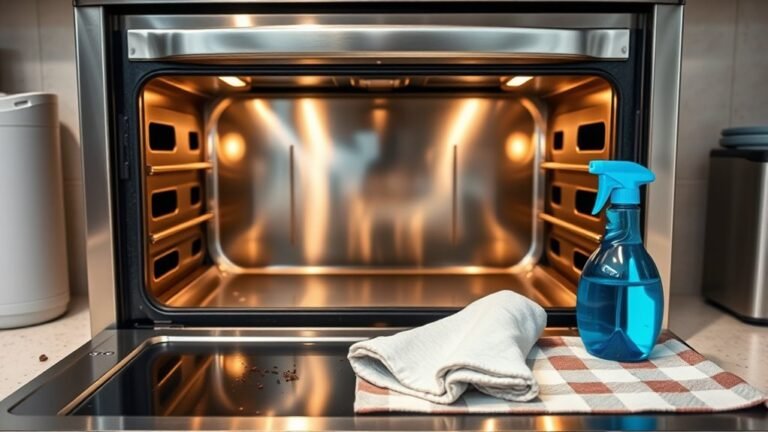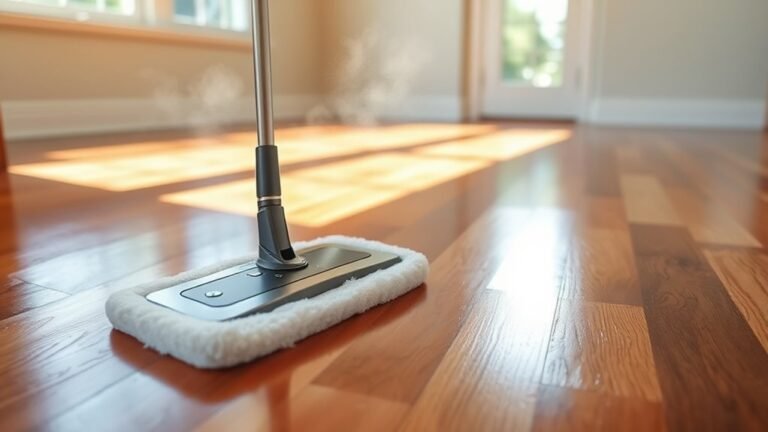How to Remove Allergens From AC
To remove allergens from your AC, regularly replace or clean air filters—HEPA filters work best to trap microscopic particles. Clean evaporator and condenser coils using appropriate solutions to prevent allergen buildup. Inspect and seal ductwork properly to stop dust and mold spores from circulating. Control indoor humidity between 30-50% to inhibit mold growth. Scheduling professional maintenance helps catch hidden issues and guarantees system efficiency. Keep exploring for detailed steps to maintain cleaner, healthier indoor air.
Understanding Allergens in Your AC System

Although your AC system is designed to improve indoor air quality, it can also harbor various allergens like dust, pollen, mold spores, and pet dander. These allergen sources accumulate in the ductwork, evaporator coils, and air handler components, creating a breeding ground for contaminants. You should understand that as air circulates through the system, these particles disperse throughout your living space, compromising air quality and potentially triggering allergic reactions. Identifying these allergen sources is essential for effective mitigation. Since your AC system continuously cycles air, even microscopic particles can reduce your freedom to breathe cleanly indoors. To maintain ideal indoor air quality, you must recognize how these contaminants infiltrate and persist within your AC system, empowering you to take targeted actions for allergen control and healthier air circulation.
Replacing and Cleaning Air Filters Regularly
Because air filters trap dust, pollen, and other allergens before they enter your HVAC system, regularly replacing and cleaning them is critical to maintaining ideal air quality. You’ll find various filter types—fiberglass, pleated, and HEPA—each offering distinct benefits. Fiberglass filters are inexpensive but less effective, while pleated filters capture smaller particles, improving allergen removal. HEPA filters provide the highest efficiency, trapping up to 99.97% of airborne particles, ideal if you want maximum freedom from allergens. To maintain performance, check your filters monthly; replace disposable ones every 1-3 months, and clean reusable filters according to manufacturer instructions. Neglecting this reduces airflow, strains your system, and compromises air quality. By staying proactive, you guarantee your AC delivers clean, allergen-free air, supporting your health and comfort without restrictions.
Cleaning Evaporator and Condenser Coils

You need to clean the evaporator and condenser coils regularly because accumulated dirt reduces airflow and traps allergens, impacting your AC’s efficiency. Use specialized coil cleaning sprays or mild detergent solutions, ensuring you power off the unit before starting. For peak performance, schedule coil maintenance at least twice a year, or more frequently in dusty environments.
Coil Cleaning Importance
When dust and debris accumulate on your evaporator and condenser coils, their efficiency drops considerably, which can worsen indoor air quality and increase allergen presence. Regular coil maintenance is essential to guarantee your AC system operates at peak performance. Dirty coils restrict airflow and reduce heat transfer efficiency, forcing your unit to work harder and consume more energy. This inefficiency not only elevates utility costs but also promotes mold and allergen buildup, compromising your freedom to breathe clean air. By prioritizing coil cleaning, you improve heat exchange, enhance cooling capacity, and prevent system overloads. Maintaining clean coils extends equipment lifespan and sustains ideal indoor conditions, ultimately supporting your goal of a healthy, allergen-free environment. Don’t overlook this crucial step in your AC upkeep routine; it’s key to efficiency improvement and air quality control.
Cleaning Methods Overview
Maintaining clean evaporator and condenser coils directly impacts your AC’s efficiency and air quality, making effective cleaning methods a key focus. Start by performing allergen identification to spot mold, dust, and pollen buildup on coils. For natural cleaning, use a mixture of water and mild detergent or vinegar, which safely breaks down debris without harsh chemicals. Apply the solution gently with a soft brush or spray bottle, ensuring you avoid coil damage. Rinse thoroughly with low-pressure water to remove residues. For stubborn grime, specialized coil cleaners designed for HVAC systems can be used, but always verify their environmental safety. Proper coil cleaning restores airflow, reduces allergens circulating indoors, and supports your system’s longevity. This technical approach gives you control over your AC’s cleanliness, improving your indoor freedom and comfort.
Maintenance Frequency Tips
Although the exact frequency depends on factors like usage intensity, environmental conditions, and allergen presence, cleaning your evaporator and condenser coils at least twice a year is generally recommended. Adhering to seasonal maintenance guarantees efficiency and allergen control. Here’s a quick frequency guideline to help you plan:
| Condition | Recommended Cleaning Frequency |
|---|---|
| Moderate Use & Low Allergens | Twice a year (Spring, Fall) |
| High Usage or Allergy Season | Every 3-4 months |
| Dusty or Polluted Environment | Quarterly or more frequent |
Following these frequency guidelines not only prolongs your AC’s lifespan but also maintains peak airflow, reducing allergen buildup. Remember, neglecting coil cleaning can lead to restricted airflow and higher energy consumption, limiting your freedom to enjoy clean, allergen-free air. Adjust your seasonal maintenance schedule based on your specific environment and allergen exposure for the best results.
Maintaining and Sealing Air Ducts

Since air ducts are the main pathways for conditioned air to travel throughout your home, ensuring they are properly maintained and sealed is essential to minimizing allergen infiltration. Start by inspecting ducts for leaks or gaps—these can allow dust, mold spores, and other allergens to enter your airflow system. Use mastic sealant or metal tape for duct sealing, avoiding duct tape as it degrades over time. Proper sealing improves airflow optimization, allowing your AC to function efficiently while reducing the circulation of contaminants. Additionally, schedule regular professional duct cleanings to remove accumulated debris that can harbor allergens. Pay attention to duct insulation as well; damaged insulation can cause condensation and mold growth. By maintaining and sealing your ducts rigorously, you control allergen entry points and enhance indoor air quality, promoting a healthier, freer living environment.
Using Air Purifiers and Dehumidifiers With AC
How can you enhance your AC system’s ability to reduce allergens and moisture simultaneously? Integrating air purifiers and dehumidifiers with your AC provides targeted air quality improvement and humidity control. Air purifiers, equipped with HEPA or activated carbon filters, trap microscopic allergens like pollen, dust mites, and pet dander that your AC’s standard filter might miss. Meanwhile, dehumidifiers regulate indoor humidity levels, preventing mold and mildew growth that thrive in damp environments. By maintaining relative humidity between 30-50%, you not only inhibit allergen proliferation but also optimize your AC’s efficiency. Position the air purifier in high-traffic or allergen-prone rooms and use a dehumidifier in areas with persistent moisture. This combined approach guarantees cleaner air circulation and stable humidity, granting you greater control over your indoor environment’s comfort and health.
Scheduling Professional HVAC Maintenance
When you want to guarantee your AC system consistently removes allergens effectively, scheduling professional HVAC maintenance is essential. Routine inspections performed by skilled technicians identify and address issues that could reduce your system’s ability to filter allergens. Technician expertise guarantees components like filters, coils, and ducts are cleaned, repaired, or replaced precisely when needed, preventing allergen buildup. These experts also calibrate your system to maintain ideal airflow and humidity levels, crucial for allergen control. By adhering to a maintenance schedule, you protect your investment and secure cleaner indoor air without compromising your freedom or comfort. Don’t wait for problems; proactive professional care keeps your AC running efficiently, safeguarding your environment against allergens year-round.
Frequently Asked Questions
Can Pets Increase Allergens in My AC System?
Yes, pets can increase allergens in your AC system because pet dander is a common allergy trigger. When pets shed skin flakes, these particles circulate through your home and get trapped in your AC filters and ducts. Over time, this buildup reduces air quality and can worsen allergy symptoms. To maintain a healthier environment, regularly clean or replace your AC filters and consider using high-efficiency filters designed to capture pet dander effectively.
Do UV Lights Help Reduce Allergens in AC Units?
Think of UV light effectiveness as a silent guardian inside your AC unit, zapping allergens like mold spores and bacteria before they spread. UV lights can appreciably aid allergen reduction by disrupting the DNA of these microscopic invaders, preventing their growth on coils and filters. While not a standalone solution, combining UV lights with proper filtration and maintenance can give you practical, freedom-enhancing relief from airborne irritants in your home environment.
How Often Should AC Vents Be Cleaned Professionally?
You should follow frequency guidelines recommending professional AC vent cleaning every 3 to 5 years, though homes with pets or allergy sufferers might need it more often. Regular cleaning benefits include improved indoor air quality and enhanced system efficiency, which saves energy and extends your unit’s lifespan. Staying proactive with vent maintenance guarantees your freedom from allergens and respiratory issues, letting you enjoy a healthier, more comfortable living space without constant worry about hidden contaminants.
Are Washable Filters as Effective as Replaceable Ones?
Imagine your AC filter like a sieve catching tiny particles. Washable filters offer decent filter efficiency but can lose effectiveness if not cleaned properly. You’ll need regular maintenance—rinsing, drying thoroughly—to keep them performing well. Replaceable filters often provide more consistent filtration, especially for allergies. If you want freedom from frequent upkeep, replaceable might suit you better. However, with disciplined maintenance tips, washable filters can still serve efficiently.
Can Houseplants Reduce Indoor Allergens With AC Running?
You might find that houseplants benefits include modest improvements to indoor air quality, even with your AC running. Plants can absorb certain airborne toxins and increase humidity, which may help allergens settle. However, their impact is limited compared to mechanical filtration systems. To maximize freedom from allergens, use houseplants alongside efficient AC filters and regular maintenance. Remember, plants alone won’t eliminate allergens but can complement your overall air-cleaning strategy effectively.






